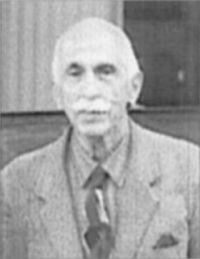

 The South African
The South African

Brigadier Nand lal Kapur MC
The Military History Society recently sustained a great loss with the death of Brigadier Nand Lal Kapur MC (Indian Army retired). He was a very good friend to all of us and added to the prestige of the Society by his attendance at our meetings during the three years of his sojourn in South Africa.
Brigadier Kapur was commissioned in the Indian Land Forces in 1941 and was posted to the 4th Battalion (Outram's Rifles), 6th Rajputana Rifles, which was serving with the 10th Indian Division at Mersa Matruh in the Western Desert. He had a swift introduction to the realities of modern war - three weeks after his arrival, he took part in the battle of Matruh, 26-27 June 1942. During the breakout from Matruh, he decided to avoid the coast road and brought his company back to El Alamein. In mid-July 1942, the 5th Indian Brigade was in the front-line near Ruweisat Ridge and was involved in heavy fighting. On 17 July 1942, Lt Nand Lal Kapur took part in and commanded an extremely hazardous operation, during which his company came under fire from German tanks. Ordering his men to lie down, he walked up and down in front of them, causing the commander of the tanks to suspect a trap. The situation remained unchanged until dark, when Lt Kapur withdrew his company. His courage earned him the Military Cross. Nand Lal Kapur also took part in the second battle of El Alamein, the battles of Mareth Line and the storming of the Wadi Akarit position. He was wounded during the attack on Djebel Garci.
During his recovery, he was appointed ADC to the Viceroy of India, Field Marshal the Viscount (later Earl) Wavell. This was a considerable honour to him and his regiment. In January 1944, Nand Lal Kapur returned to battle with the 4th Indian Division in Italy and fought at Monte Cassino. After Cassino, he returned to India with his regiment and, immediately after the war, trained as a paratrooper. Thereafter, he became the first Indian military attache to Kabul and later commanded a Gorkha* battalion. He held the post of Military Secretary to the Chief of Staff of the Indian Army and ended his career in command of a Gorkha brigade.
Nan Lal Kapur enriched our lives and we benefitted enormously from his wide and deep knowledge of military matters. He also helped to make the Society known to a wider audience and enhanced the cultural perspectives of our members. To use Kipling's words, we hope that his gods will reward him for this widening of our world view. We extend our deepest condolences to his family.
Hamish Paterson
Education Officer/Curator of Artillery South African National Museum of Military History
* In February 1949, the term 'Gorkha' was adopted by the Indian Army.
Return to Journal Index OR Society's Home page
South African Military History Society / scribe@samilitaryhistory.org